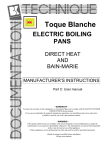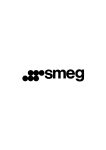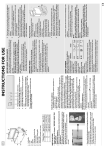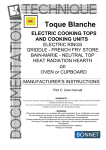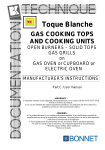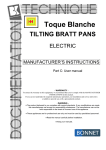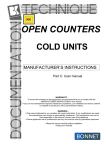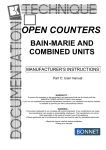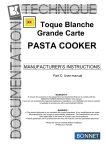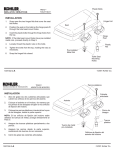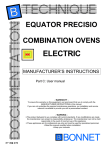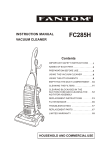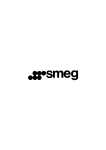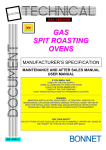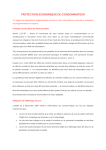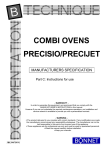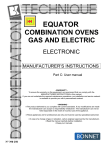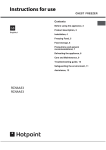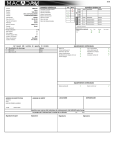Download Toque Blanche GAS BOILING PANS
Transcript
9 Toque Blanche GAS BOILING PANS DIRECT HEAT AND BAIN-MARIE MANUFACTURER’S INSTRUCTIONS Part C: User manual - WARRANTY To ensure the warranty on this equipment, we recommend thas you to comply with the MANUFACTURER INSTRUCTIONS in this manual. If you can not undertake the required maintenance operations, our installation and service network is available to provide you with a personalized contract. - WARNING - • The product delivered to you complies with current standards. If any modifications are made the manufactureer can accept no responsibility whatsoever. The manufacturer can not be held responsible in the event of incorrect use of the appliance. • These appliances are for professional use only and must be used by specialised personnel. • In case of a change of gas or relocation, call an engineer approved by the manufacturer. • Read the manual carefully before installation. • Keep your manuals. Page 1 CONTENTS GAS BOILING PANS DIRECT HEAT AND BAIN-MARIE C) USER MANUAL 1. Recommendations ............................................................................. 2 2. Practical tips for use ........................................................................... 3 3. Maintenance ...................................................................................... 6 Warranty ............................................................................................ 9 BONNET CIDELCEM GRANDE CUISINE Siége social: Rue des Frères Lumière - Z.I Mitry Compans 77292 MITRY MORY Cedex Page 2 C: USER MANUAL 1. RECOMMENDATIONS WARNING ♦ These appliances are for professional use, they must be used by qualified personnel. ♦ Cooking appliances and heating compononts reach high temperatures. ♦ BE CAREFUL not to burn yourself when using or handling accessories (grills, plates...). ♦ Gas appliances are fitted with burnt gases exhaust flue vents: BE CAREFUL NOT TO OBSTRUCT THESE OUTLETS. ♦ For cleaning, never use high pressure sprays or hoses. ♦ The appliance must be installed to current with regulations and standards, in an area which is correctly ventilated. ♦ The required fresh air flowrate for combustion is 2 m3/h per kW of calorific consumption. ♦ To ensure correct, long and safe operation of thisappliance, maintenance should be carried out by qualified personnel twice a year ( cleaning of injectors and venturi pipes, adjustment of air rings, gas leak inspection, greasing of gas taps...). ♦ THIS APPLIANCE IS NOT TO BE USED AS A DEEP FAT FRYER OR BRATT PAN ♦ The manufacturer certifies that the packing conforms to directive 94/62/CE of 20.12.94 and requests that the final recipient respects the directive with regard to recycling or reuse of the packaging materials. ♦ The warranty will not cover problems caused by failure to heed these recommendations. BONNET CIDELCEM GRANDE CUISINE Siége social: Rue des Frères Lumière - Z.I Mitry Compans 77292 MITRY MORY Cedex Page 3 2. PRACTICAL TIPS FOR USE 2.1 TANK DIMENSIONS AND VOLUMES Dimensions Models MA 110 Height x diameter in mm 465 x 422 ∅ Effective volume in litres 60 2.2 GENERAL POINTS Bain-marie boiling pans are better suited for cooking delecate dishes than direct heat boiling pans. Boiling pans, and direct heat boiling pans in particular, must never be heated without a product in the tank: otherwise this can cause irreversible damage to the tank bottom. 2.3 COOKING MILK Cooking milk is a delicate task which is preferably done in a bain-marie boiling pan. It is recommended to rinse the tank out with water between cookings. After draining the tank, cool it with water in order to prevent any trace of milk remaining on the sides and bottom from sticking and burning. 2.4 FILLING OF DOUBLE PAN FOR BAIN-MARIE BOILING PANS Every morning, fully open the tap A until water runs out of the overflow. Slowly close it : filling stops ; allow surplus water to drain, then close completely. The appliance is now ready for use. Note: during filling, do not operate safety valve. WARNING - Only use the double pan filling tap in the morning when the boiling pan is cold. - Water consumption by the appliance is sufficiently low to ensure double pan service throughout the day. - Never use the safety valve during daily use when the double pan is hot. This is because if steam saturates in the double pan and then condenses it may result in a water level which is higher than the authorised maximum. This may result in hot water being discharged by the safety valve. BONNET CIDELCEM GRANDE CUISINE Siége social: Rue des Frères Lumière - Z.I Mitry Compans 77292 MITRY MORY Cedex Page 4 SOLUTION: If the double pan is accidentally filled when the boiling pan is hot, - Cut off the source of heat. - Half-open filling tap A (2 turns). Allow the steam and surplus water to escape for 2 or 3 minutes (if necessary increase the speed of the operation by opening the safety valve). - As soon as no more water is running, completely open the tap and follow the operating instructions as described in 2.4. 2.5 USE - Fill the boiling pan with the product to be cooked. - Start heating. - Press control lever and turn it to ignition position. Holding the control lever down, activate the pushbutton to ignite the pilot flame and wait at least 5 seconds before releasing. - If pilot flame goes out, repeat the operation increasing the hold time. - To ignite burner, turn control lever anti-clockwise. To switch to high heat and low heat, press the control lever and adjust by turning it anti-clockwise (see diagram). - Reduce heat as soon as the product has been brought to boil or has reached the right temperature. Remark: for user safety and comfort, start mecanical ventilation controlled at the same time as burners and never obstruct the burnt gases outlet. 2.6 BOIL-DRY SAFETY SYSTEM For Bain-marie boiling pans, a safety service cuts off the heat supply in the absence of water in the double pan. Fill tank (see Section 2.4 ) BONNET CIDELCEM GRANDE CUISINE Siége social: Rue des Frères Lumière - Z.I Mitry Compans 77292 MITRY MORY Cedex Page 5 2.6 SOME EXAMPLES OF CAPACITIES AND COOKING TIMES TEMPERATURE Foods Boiled beef with vegetables Poultry Veal/Venison Tuna steacks Potatoes Carrots Green beans Dry beans Creole rice Pasta Broth Bisque Cream dessert 98° 80° 70° 85° 98° 98° 100° 90° 98° 98° 98° 80° 70° Time Load 120 ' 70' 150' 30' 55' 65' 45' 90' 15' 10' 55' 55' 35' MA 60 20 kg 20 piec. 3 piec. 20 kg 40 kg 40 kg 40 kg 21 kg 17 kg 13 kg 60 litres 60 litres 60 litres Practical advice Scald, cool , cook Skim during cooking Cold desalt, scald. Poach in savoury broth Poach in fumet, skim Cold start, skim, salt Cold start, skim Poach, lid open Cold start Warm start, salted water, coo l Poach, stir, cool Poach, cook, mix (if necessary) Poach ground shells, skim, str ain Sift, clear, cool tank BONNET CIDELCEM GRANDE CUISINE Siége social: Rue des Frères Lumière - Z.I Mitry Compans 77292 MITRY MORY Cedex Page 6 3. MAINTENANCE 3.1 ABOUT STAINLESS STEELS A stainless steel is a type of steel designed to allow a thin protective film to form on the metal surface and to protect it against corrosion (Oxide film resulting from the chemical reaction of oxygen on the metal surface). Any element disturbing the formation of this film, or making its partial destruction easier (Food deposits, overflows, stagnant liquids...) affects stainless steel resistance to corrosion. If the composition of stainless steel allows it to resist certain chemical aggressions better than standard steel do not imagine that stainless steel is indestructible. 3 main factors of corrosion should be checked: - The chemical environment. In general: * Diverse brines (Salt concentration, Sauerkrauts …) * Chlorides, particularly in: - Cleaning products - Bleach. - Temperature: Any chemical environment has its aggression towards stainless steel considerably increased at higher temperature. - Time: The more important the contact time between stainless steel and the chemical environment is, the more perceptible the consequences of the corrosion will be. The combination of these three factors can lead to the destruction of interior surfaces, even those of high quality stainless steel. Note: when a stainless steel corrodes, it is extremely rare that it comes from the steel itself. Generally, inappropriate or badly used cleaning products, bad maintenance or extreme conditions of use are often the cause of the problems encountered. WARNING The manufacturer can not be held responsible for cases of corrosion encountered in these conditions and no warranty will then apply. A list of the most frequent cases is given below, so that you can identify these possible causes and maintain your equipment's service life as long as possible. BONNET CIDELCEM GRANDE CUISINE Siége social: Rue des Frères Lumière - Z.I Mitry Compans 77292 MITRY MORY Cedex Page 7 3.2 THE MOST COMMON CAUSES OF CORROSION: Floor cleaning The cleaning of tiles (after work, or during regular service) is often carried out with very aggressive products. If the product is sprayed under pressure without caution, the splashes beneath the appliances cause corrosion of bottoms and panels. Even worst, the vapour from these products, if the premises are not immediately and forcefully ventilated, fall on the equipment and can extend the corrosion to all surfaces. Inappropriate cleaning products (Bleach, Acids, Soda) If products, such as Bleach, acids or soda dilutions,... (all products not especially designed for use on stainless steels) are used, an irreversible attack occurs on the stainless steel surfaces. Cleaning product applied at too high temperature All cleaning products become more aggressive if applied to a hot surface. As a general rule, the temperature must not be higher than 60°C, not to attack the stainless steel in an irreversible way (Blackening of surfaces...). Cleaning product not properly rinsed If the interior surfaces once cleaned are not thoroughly rinsed in order to eliminate any trace of cleaning product, the latter, with time, will carry on its action and risk provoking corrosion. Even worst, if this interior surface reaches temperatures higher than 60°C (Inside an oven, a well, cooking-top...), the problems mentioned previously, will inevitably occur. Stagnation of cleaning products In the same way, any zone that can retain some cleaning products, particularly gutters, drains of combi ovens, taps,... must be rinsed thoroughly and abundantly. (Use a nylon brush to strengthen the rinse action with clear water). Salt concentration Salt, which is an ordinary element in cookery, often causes attacks (pinholes) in stainless steel. Spillage on the cooking surfaces must be cleaned immediately Special case of boiling in a boiling pan: Salting the water by throwing cooking salt into the tank, presents risk: The cooking salt, by setting at the bottom of the tank, may well, before dissolving, corrode the bottom in an irreversible way, if the operation is frequent. Water should be stirred until the salt has completely dissolved, or table salt should be used. Intensive use in brined environment Certain products such as sauerkraut (acid juices), seafood (presence of salt), and generally speaking, brine should be given particular attention. In case of occasional use and standard equipment this does not pose problem, if they are thoroughly and systematically cleaned after each use. In case of intensive treatment, cooking equipment (Cooking ovens, boiling pans...) should be chosen with steel specifically designed for this type of operation. BONNET CIDELCEM GRANDE CUISINE Siége social: Rue des Frères Lumière - Z.I Mitry Compans 77292 MITRY MORY Cedex Page 8 Mains water too chlorinated At times certain water supplies have too high a chlorine content. In these cases, it is not rare to find the corrosion problems mentioned above. (Notably in the well of boiling pans, bratt pans, bain-marie,…). Cleaning Aluminium or aluminised iron accessories The presence of aluminium or aluminised iron in a chlorinated solution considerably increases attack against stainless steel. Do not leave accessories such as basket filters or any aluminium ovenware in tanks of boiling pans, frying pans ... One night would be enough to attack stainless steel at the level of the contact points and on the surface of the product. 3.3 MAINTENANCE OF STAINLESS STEEL SURFACES A minimum standard of cleanliness and maintenance is essential for metal surfaces to prevent dust, metallic particles and deposits of all kinds that may alter the protective film mentioned. Washing surfaces down with soapy water or a neutral non-abrasive detergent is all that is required. RINSE THOROUGHLY and wipe surfaces. Never rub stainless steel with wire wool. If necessary use scotch brite or equivalent product, following the polishing direction of the stainless steel surface. 3.4 SERVICING OF GAS CONTROL To ensure correct, long and safe operation of the appliance, a service call should be carried out by qualified staff on a twice a year basis ( cleaning of injectors and venturi tubes, adjustment of air rings, leak inspection, greasing of gas taps, checking of controls and safety systems). IN CASE OF GAS CHANGE, CALL A QUALIFIED FITTER. 3.5 INSPECTION AND MAINTENANCE Check the appliance is correctly operating after a new installation or after a routine service. It is recommended to have the overall operation of the appliance checked at least once every year. WARNING: ♦ ♦ ♦ NEVER CLEAN THE APPLIANCE WHEN IT IS STILL WARM, HOTTER THAN 60° C. The warm tank will be attacked instantly (dark almost black colouration). Never use high pressure sprays or hoses: under no circumstances should the appliance be cleaned with a water jet. The warranty will not cover problems caused by failure to heed the above. BONNET CIDELCEM GRANDE CUISINE Siége social: Rue des Frères Lumière - Z.I Mitry Compans 77292 MITRY MORY Cedex Page 9 GUARANTEE WARNING! NO WARRANTY IS UNCONDITIONAL Our warranty only applies to normal usage, i.e. in strict compliance with the recommendations indicated in our service and maintenance notices. It is also only valid if our technicians carry out the regular recommended service and/or inspection visits. Subject to the above reservations, our appliances are normally guaranteed for a period of one year, running from their date of manufacture. In the event of breakdowns due to defects or to constructional errors either apparent or hidden, throughout the period of warranty our appliances are repaired at our cost, parts and labour included. For the warranty to be effective our appliances should not have been modified nor repairs carried out with parts which are not original or approved by us, or by non-qualified personnel or those who have not been trained by us. In the event of a breakdown or failure, the purchaser should inform us in writing as soon as possible of any defects attributed to our appliances. No attempt should be made to remedy the defect directly or via a third party. Regular service inspections and maintenance by our engineers are an essential condition for correct and reliable operation of our equipment. Such service and maintenance operations can and must only be carried out by our technicians, who are not only fully qualified but trained to do so. They have the right tooling, original spare parts and are given regular training updates on the appliances. Periodic servicing is essential, it is carried out at a cost but guarantees reliable operation of our appliances. The timing of service and maintenance is relative to the conditions of use. In the event of heavier conditions, it will be necessary to carry out certain operations more frequently. WARNING: Damage caused by the connection of our appliances to a power supply which does not comply with the instruction plate (voltage, phase/neutral cycles...) or with the phase order (particularly important for three-phase motors, direction of ventilation, jacks...) shall in no case be covered by our warranty. This is why it is recommended that the appliances are only connected when power is available and these things can be checked. BONNET CIDELCEM GRANDE CUISINE Siége social: Rue des Frères Lumière - Z.I Mitry Compans 77292 MITRY MORY Cedex










